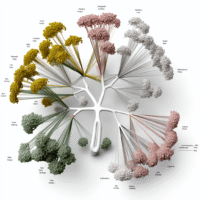AI Tech News
-
Build a Conversational Research AI Agent with LangGraph: A Step-by-Step Guide for Developers and Data Scientists
Understanding the Target Audience The main audience for this tutorial includes developers, data scientists, and business managers who are eager to leverage AI-driven solutions. They come from diverse backgrounds, with varying levels of technical expertise, but they all share a common goal: improving business operations through innovative AI technologies. Pain Points Lack of knowledge about […] ➡️➡️➡️
-
Chunking vs. Tokenization: Essential Insights for AI Text Processing
When diving into the world of artificial intelligence and natural language processing, two concepts often come to the forefront: tokenization and chunking. These techniques are essential for breaking down text, but they serve distinct purposes and operate on different levels. Understanding their differences is crucial for developing effective AI applications. What is Tokenization? Tokenization is […] ➡️➡️➡️
-
Build a Brain-Inspired AI Agent: A Coding Guide Using Hugging Face Models for Data Scientists and AI Enthusiasts
This tutorial is designed to guide you through creating a Brain-Inspired Hierarchical Reasoning AI Agent using Hugging Face models. It’s aimed at individuals such as data scientists, students, and business managers who want to deepen their understanding of AI and its practical applications. By breaking down complex problems into manageable parts, you’ll learn to build […] ➡️➡️➡️
-
Microsoft’s rStar2-Agent: Revolutionizing Math Reasoning with Agentic Reinforcement Learning
The Problem with “Thinking Longer” Large language models have significantly improved in mathematical reasoning, often by extending their Chain-of-Thought (CoT) processes. This method involves “thinking longer” through detailed reasoning steps. However, this approach has its drawbacks. When models make subtle errors in their reasoning chains, these mistakes can compound rather than be corrected. Often, internal […] ➡️➡️➡️
-
MCP-Bench: A Game-Changer in Evaluating LLM Agents for Real-World Applications
Understanding the Target Audience for MCP-Bench The target audience for Accenture Research’s MCP-Bench includes AI researchers, business managers, and technology decision-makers. These individuals are primarily focused on integrating AI solutions into their operations and are eager to understand the capabilities and limitations of large language models (LLMs) in real-world applications. Pain Points This audience often […] ➡️➡️➡️
-
Top 20 Voice AI Blogs and News Websites for Professionals in 2025
Understanding Voice AI: The Landscape in 2025 Voice AI technology has seen remarkable advancements in 2025, particularly in areas like real-time conversational AI, emotional intelligence, and voice synthesis. As businesses increasingly adopt voice agents and consumers embrace next-generation AI assistants, keeping up with the latest developments is vital for professionals across various sectors. The global […] ➡️➡️➡️
-
Microsoft Launches MAI-Voice-1 and MAI-1-Preview: Revolutionizing Voice AI for Developers and Content Creators
Introduction to Microsoft’s New AI Models Microsoft AI Lab has recently unveiled two groundbreaking models: MAI-Voice-1 and MAI-1-preview. These innovations mark a significant step in Microsoft’s journey to develop artificial intelligence solutions internally, without relying on third-party technologies. Each model serves a unique purpose, focusing on voice synthesis and language understanding, respectively. MAI-Voice-1: A Leap […] ➡️➡️➡️
-
Optimize Machine Learning Pipelines with TPOT: A Guide for Data Scientists and Engineers
Understanding the Target Audience for Building and Optimizing Intelligent Machine Learning Pipelines with TPOT The ideal audience for this content primarily consists of data scientists, machine learning engineers, and business analysts who are keen on automating and optimizing machine learning processes. These professionals often operate in tech-driven environments where efficiency, accuracy, and delivering business value […] ➡️➡️➡️
-
Voice AI in 2025: Key Trends and Innovations for Business Leaders
Understanding the Growing Influence of Voice AI Voice AI technology is rapidly evolving, reshaping how businesses communicate with customers and streamline operations. The driving forces behind this growth include the need for efficient automation and enhanced user interactions. For business leaders and technology managers in sectors like healthcare, finance, and retail, understanding these dynamics is […] ➡️➡️➡️
-
Cut Your AI Training Costs by 80%: Discover Oxford’s 7.5x Faster Optimizer Solution
The rapid advancement of artificial intelligence (AI) has brought both opportunities and challenges, especially in the realm of AI model training. A significant concern for many startups and established companies alike is the high cost associated with GPU computing. Recent research from Oxford has introduced an innovative optimizer, Fisher-Orthogonal Projection (FOP), that has the potential […] ➡️➡️➡️
-
OpenAI Unveils Advanced Speech-to-Speech Model and Real-time API for Enterprises
Understanding the Target Audience The recent advancements from OpenAI, particularly the launch of the Realtime API and GPT-Realtime, cater primarily to business leaders, software developers, and IT managers. These individuals are focused on integrating cutting-edge AI technologies into their operations to boost efficiency and productivity. Their main concerns typically involve ensuring high accuracy in voice […] ➡️➡️➡️
-
Supercharge LLM Memory Agents: How Reinforcement Learning Transforms AI Performance
Understanding the Target Audience The target audience for Memory-R1 includes AI researchers, business managers, and technology executives who are keen on integrating artificial intelligence into their business processes. They face challenges such as: Limitations of current large language models (LLMs) in managing persistent memory. Difficulty in accurately reasoning over complex conversation histories. Inefficiencies of traditional […] ➡️➡️➡️
-
Groundbreaking PadChest-GR Dataset: Transforming Radiology Reporting with Expert-Labeled AI Data
Recent advancements in medical AI have shown that the success of these technologies relies heavily on the quality of the data used to train them. This article delves into a significant collaboration among Centaur.ai, Microsoft Research, and the University of Alicante, which led to the creation of PadChest-GR. This innovative dataset represents a major step […] ➡️➡️➡️
-
Build an Efficient Multi-Round Research Agent Using Gemini and DuckDuckGo API
How to Build a Multi-Round Deep Research Agent In today’s fast-paced world, gathering and analyzing information efficiently is crucial for success in various fields, from data science to business analysis. This article guides you through creating a modular deep research system using Gemini, DuckDuckGo’s API, and automated reporting, all within Google Colab. By the end, […] ➡️➡️➡️
-
Australia’s Path to Local Large Language Models: Challenges and Opportunities for AI Development
Understanding the Target Audience The target audience for this assessment includes AI researchers, business leaders, policymakers, and academic professionals in Australia. They face challenges in relying on international large language models (LLMs), which often do not align well with Australian English or cultural nuances. Moreover, they are keen on enhancing data sovereignty and improving local […] ➡️➡️➡️
-
Introducing Hermes 4: Breakthrough Open-Weight AI Models with Hybrid Reasoning for Developers and Researchers
Introduction to Hermes 4 The recent launch of Hermes 4 by Nous Research marks a significant milestone in the realm of open-weight AI models. With three different parameter sizes—14B, 70B, and 405B—this family of models is built on Llama 3.1 checkpoints and showcases advanced performance through innovative post-training techniques. One of the standout features of […] ➡️➡️➡️
-
Advanced QuTiP Tutorial: Quantum State Evolution, Decoherence, and Entanglement Dynamics for Aspiring Quantum Programmers
Understanding Quantum State Evolution with QuTiP Quantum mechanics can seem daunting, but tools like QuTiP (Quantum Toolbox in Python) make it easier to explore the fascinating dynamics of quantum systems. This tutorial will guide you through the essential concepts of quantum state preparation, quantum gates, dynamics, decoherence, and entanglement, all using Python. Whether you’re an […] ➡️➡️➡️
-
Understanding Agentic RAG: Use Cases and Top Tools for 2025
Understanding Agentic RAG Agentic RAG, or Retrieval-Augmented Generation, is an innovative approach that enhances traditional RAG by incorporating autonomous decision-making and tool usage. Unlike static methods, Agentic RAG utilizes AI agents that can orchestrate the entire process of retrieval and generation. These agents are capable of determining the best data sources, refining their queries, invoking […] ➡️➡️➡️
-
Meta AI’s DeepConf: Achieving 99.9% Accuracy in AI Reasoning with Open-Source Models
Understanding DeepConf DeepConf, developed by Meta AI and UCSD, is a groundbreaking approach to enhancing the reasoning capabilities of large language models (LLMs). Traditional methods, such as parallel thinking, have been effective but come with significant computational costs. DeepConf aims to bridge the gap between accuracy and efficiency, achieving remarkable results in reasoning tasks. Why […] ➡️➡️➡️
-
Google AI’s RLM Framework: Revolutionizing Industrial Performance Prediction from Raw Text Data
Understanding the Target Audience The primary audience for Google AI’s Regression Language Model (RLM) framework includes data scientists, AI researchers, industrial engineers, and business managers in sectors such as cloud computing, manufacturing, and IoT. These professionals are typically tasked with optimizing performance and efficiency in large-scale industrial systems. Pain Points These experts face challenges in […] ➡️➡️➡️
















